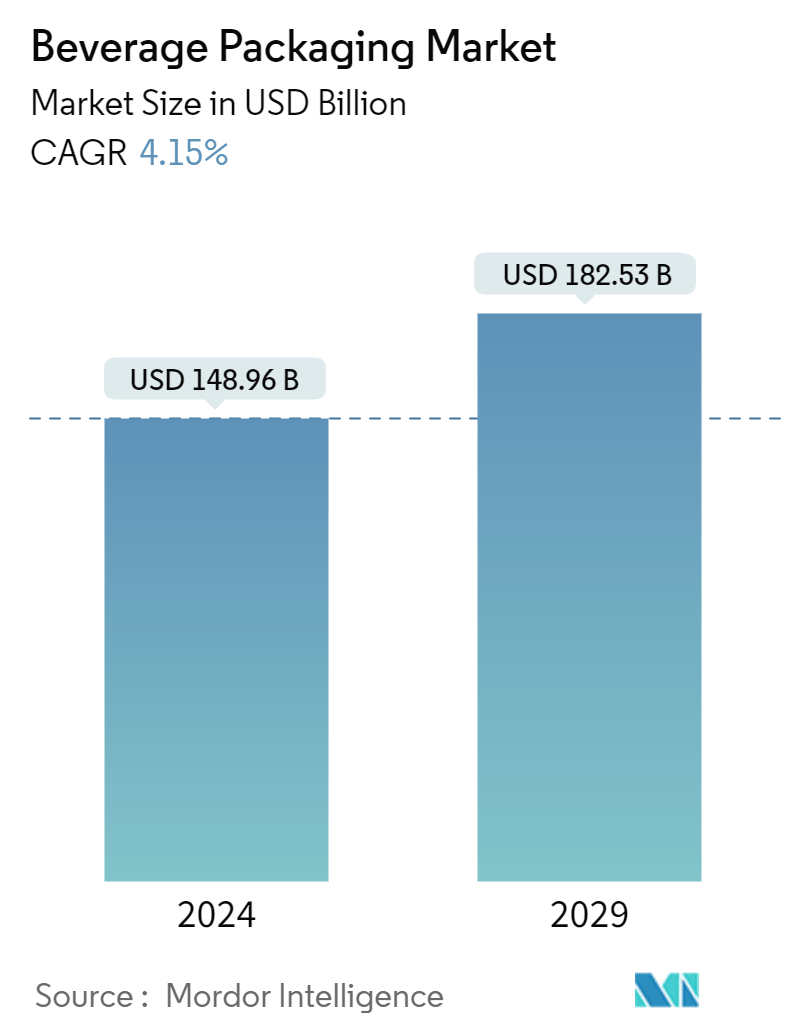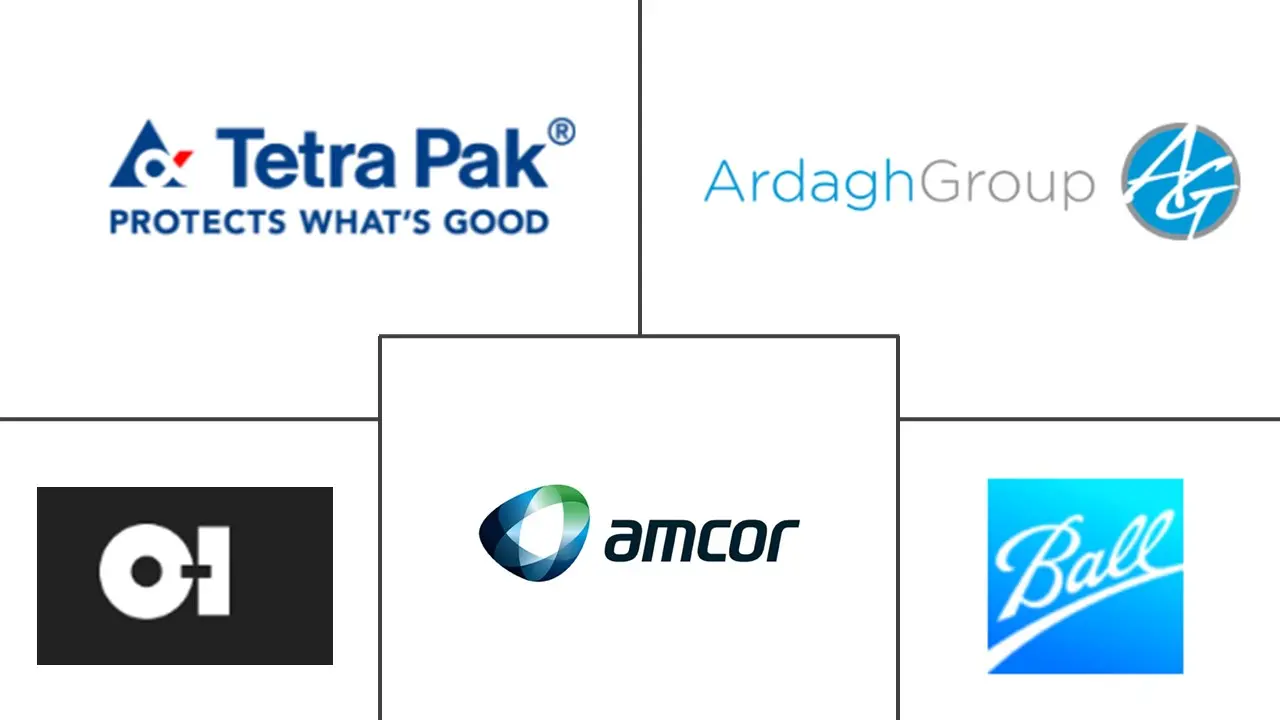Market Size of Beverage Packaging Industry

| Study Period | 2019 - 2029 |
| Market Size (2024) | USD 148.96 Billion |
| Market Size (2029) | USD 182.53 Billion |
| CAGR (2024 - 2029) | 4.15 % |
| Fastest Growing Market | Asia Pacific |
| Largest Market | Asia Pacific |
Major Players
*Disclaimer: Major Players sorted in no particular order |
Beverage Packaging Market Analysis
The Beverage Packaging Market size is estimated at USD 148.96 billion in 2024, and is expected to reach USD 182.53 billion by 2029, growing at a CAGR of 4.15% during the forecast period (2024-2029).
- Consumers are increasingly becoming aware of concerns related to sustainability and environmental implications, encouraging beverage companies to focus. Consequently, sustainable and biodegradable packaging, designed to reduce environmental footprints, has surged as a leading trend in beverage packaging, especially for bottlers.
- There has been a significant shift toward sustainability in beverage packaging, with more consumers prioritizing sustainability in the way in which they shop, which has become something consumers expect as standard. This shift toward sustainable solutions is seen in the widespread use of recyclable plastic containers and bottles, which reflects a larger trend toward responsible consumption and production.
- The dynamic lifestyles and the consequent dependence of consumers on packaged beverages are also augmenting the sales of beverage packaging products such as plastic and paper bottles and containers. This trend bolsters the sales of plastic products, owing to their superior barrier properties, convenient format, high-quality printability, and prudent usage of material resources.
- Furthermore, to address rising production costs, manufacturers are exploring cost-reduction strategies. These may include lightweight packaging, streamlining production processes, optimizing supply chains, and adopting new technologies to increase efficiency and reduce waste. This is leading to increased demand for lightweight beverage packaging from beverage manufacturers, with these companies emphasizing minimizing costs without compromising quality or sustainability.
- However, fluctuating raw material prices pose a significant challenge to the beverage packaging market globally. Beverage companies, heavily reliant on materials such as plastic, metal, glass, and paper, face price volatility due to factors like supply chain disruptions and oil price fluctuations contributing to this price instability, directly impacting production costs and subsequently impacting profit margins.
- The COVID-19 outbreak significantly altered consumer behavior, heightening concerns over product hygiene and sustainability. With shoppers' needs evolving, a consumer-centric approach became paramount, especially amid this pandemic. Further, shifts in consumer behavior as the market adapts to the new normal, making the outlook for beverage packaging demand post-pandemic, is expected to further accelerate demand for various beverage packaging products.
Beverage Packaging Industry Segmentation
Beverage manufacturers are focusing on offering a better product with easy-to-handle, eco-friendly packaging that keeps the product fresh for a long time. Packaging innovation is becoming a norm for beverage companies with smaller package sizes, situational package types, and multi-packs. Different kinds of products are packed using various materials depending on the beverages.
The beverage packaging market is segmented by material type (plastic, metal, glass, and paperboard), product type (bottles, cans, pouches, cartons, and beer kegs), application (carbonated drinks, alcoholic beverages, bottled water, milk, fruit and vegetable juices, energy drinks, plant-based drinks, and other applications), and geography. The market sizes and forecasts are provided in terms of value (USD) for all the above segments.
| By Material Type | |
| Plastic | |
| Metal | |
| Glass | |
| Paperboard |
| By Product Type | |
| Bottles | |
| Cans | |
| Pouches | |
| Cartons | |
| Beer Kegs |
| By Application | |
| Carbonated Drinks | |
| Alcoholic Beverages | |
| Bottled Water | |
| Milk | |
| Fruit and Vegetable Juices | |
| Energy Drinks | |
| Plant-based Drinks | |
| Other Applications |
| By Geography | |||||||||||
| |||||||||||
| |||||||||||
| |||||||||||
| |||||||||||
|
Beverage Packaging Market Size Summary
The beverage packaging market is poised for significant growth, driven by evolving consumer preferences and technological advancements. As sustainability becomes a paramount concern, beverage companies are increasingly adopting eco-friendly and biodegradable packaging solutions to minimize environmental impact. This shift is reflected in the growing use of recyclable materials, such as plastic and paper bottles, which align with the broader trend of responsible consumption. The market is also witnessing a surge in demand for lightweight packaging, as manufacturers seek to reduce production costs and enhance efficiency through innovative technologies. However, the industry faces challenges such as fluctuating raw material prices and the need to balance cost-effectiveness with quality and sustainability.
The market's expansion is further fueled by urbanization, rising disposable incomes, and the increasing popularity of ready-to-drink beverages, particularly in regions like China and Japan. The bottled water segment, in particular, is experiencing rapid growth due to its convenience and health benefits, with glass packaging gaining traction as a sustainable alternative to plastic. The industry is characterized by a high degree of fragmentation, with both global and local players engaging in strategic partnerships, mergers, and product innovations to strengthen their market positions. Regulatory developments and consumer demand for sustainable packaging solutions are driving the adoption of recycled materials and new packaging technologies, ensuring the market's continued growth and adaptation to changing consumer needs.
Beverage Packaging Market Size - Table of Contents
-
1. MARKET INSIGHTS
-
1.1 Market Overview
-
1.2 Industry Value Chain Analysis
-
1.3 Industry Attractiveness - Porter's Five Forces Analysis
-
1.3.1 Bargaining Power of Suppliers
-
1.3.2 Bargaining Power of Buyers/Consumers
-
1.3.3 Threat of New Entrants
-
1.3.4 Threat of Substitutes
-
1.3.5 Intensity of Competitive Rivalry
-
-
1.4 Assessment of the Impact of COVID-19 on the Beverage Packaging Industry
-
-
2. MARKET SEGMENTATION
-
2.1 By Material Type
-
2.1.1 Plastic
-
2.1.2 Metal
-
2.1.3 Glass
-
2.1.4 Paperboard
-
-
2.2 By Product Type
-
2.2.1 Bottles
-
2.2.2 Cans
-
2.2.3 Pouches
-
2.2.4 Cartons
-
2.2.5 Beer Kegs
-
-
2.3 By Application
-
2.3.1 Carbonated Drinks
-
2.3.2 Alcoholic Beverages
-
2.3.3 Bottled Water
-
2.3.4 Milk
-
2.3.5 Fruit and Vegetable Juices
-
2.3.6 Energy Drinks
-
2.3.7 Plant-based Drinks
-
2.3.8 Other Applications
-
-
2.4 By Geography
-
2.4.1 North America
-
2.4.1.1 United States
-
2.4.1.2 Canada
-
-
2.4.2 Europe
-
2.4.2.1 United Kingdom
-
2.4.2.2 Germany
-
2.4.2.3 France
-
2.4.2.4 Italy
-
2.4.2.5 Spain
-
2.4.2.6 Austria
-
2.4.2.7 Poland
-
2.4.2.8 Russia
-
2.4.2.9 Rest of Europe
-
-
2.4.3 Asia-Pacific
-
2.4.3.1 India
-
2.4.3.2 China
-
2.4.3.3 Japan
-
2.4.3.4 Australia
-
2.4.3.5 Rest of Asia-Pacific
-
-
2.4.4 Latin America
-
2.4.4.1 Mexico
-
2.4.4.2 Brazil
-
2.4.4.3 Rest of Latin America
-
-
2.4.5 Middle East and Africa
-
2.4.5.1 United Arab Emirates
-
2.4.5.2 Saudi Arabia
-
2.4.5.3 South Africa
-
2.4.5.4 Rest of Middle East and Africa
-
-
-
Beverage Packaging Market Size FAQs
How big is the Beverage Packaging Market?
The Beverage Packaging Market size is expected to reach USD 148.96 billion in 2024 and grow at a CAGR of 4.15% to reach USD 182.53 billion by 2029.
What is the current Beverage Packaging Market size?
In 2024, the Beverage Packaging Market size is expected to reach USD 148.96 billion.

